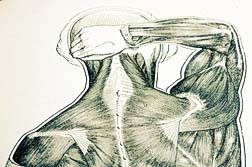 Here is yet another clarion call that the use of shoulder pain pumps, which inject pain medication directly into the shoulder for pain management, is often not a good idea—especially if it combines bupivacaine with epinephrine. The latter, according to Health Canada, is sometimes used in combination to slow down the absorption of bupivacaine.
Here is yet another clarion call that the use of shoulder pain pumps, which inject pain medication directly into the shoulder for pain management, is often not a good idea—especially if it combines bupivacaine with epinephrine. The latter, according to Health Canada, is sometimes used in combination to slow down the absorption of bupivacaine.The concern is that the combination of bupivacaine and epinephrine serves as a toxic soup for the irreplaceable cartilage that rests between the bones in the shoulder, breaking it down over time. The condition is known as chondrolysis, and it's something you don't want to have happen.
Health Canada reports that as of July of last year, there had been 8 reports of articular chondrolysis following shoulder surgery, associated with the use of a shoulder pain pump. With regard to the incident reports, all patients had been assigned pain pumps for 48 hours following surgery, and all 8 received a combination of bupivacaine and epinephrine.
Chondrolysis was diagnosed anywhere from 1 month to 1 year following their respective surgical procedures.
There have been various reports over the past several months about problems with shoulder pain pumps and, in particular, the aftermath of pumping pain medication directly into the shoulder for pain management. Pain pumps have become a bit of a rage in recent years, and a way to deliver pain relief to a patient more efficiently and effectively than via oral drugs. Injecting pain medication, by way of a catheter directly to the surgical site has proven effective.
The problem is that it appears you can't do that with the shoulder, because of the presence of cartilage. The latter has proven to have an aversion to direct contact with pain medication, and the progressive degeneration of cartilage that results can be devastating to the patient. According to the Health Canada report the joint space narrows, leading to pain and loss of motion. Further surgery to repair, or replace the shoulder is often necessary. Some patients in the US have experienced fused shoulders, and there have even been reports of deaths.
So let's translate this to the real world. What does loss of mobility in a shoulder feel like? Do you like to swim? Forget it. And even if you could, try toweling off afterwards. Try doing that with one hand. Perhaps your bad shoulder, broken down after a date with a shoulder pain pump, isn't in a sling—but it might as well be.
Try putting on a t-shirt when you can't raise your arm above your head. If it's your left shoulder, try opening the driver's-side car door, or cranking up the window when it rains.
Just imagine trying to do anything without one shoulder running, or with a shoulder that hurts so much it's practically useless. You'll soon appreciate what sufferers of chondrolysis go through. Now, imagine this happening to a young person, such as a high school jock who injures a shoulder playing football, and requires surgery. If he was hooked to a shoulder pain pump, he might not even make it to college before needing a second shoulder surgery, and even subsequent surgical procedures through his lifetime.
Pain and loss of mobility could ruin not only a promising college sports career, but also his life overall.
It should be noted that chondrolysis has yet to be fully understood, and the association of shoulder pain pumps used post-operatively and the onset of chondrolysis is difficult to identify.
READ MORE SHOULDER PAIN PUMPS LEGAL NEWS
Remember that little tidbit if you have recently had shoulder surgery, and are now experiencing pain and loss of mobility. If you were assigned a shoulder pain pump after shoulder surgery, you just may have a brand-new shoulder injury for which you could be compensated. Your shoulder pain pump lawyer will determine if the toxic soup of bupivacaine and epinephrine was used.
That's important, because this just may be a chronic shoulder problem that will haunt you, and cost you for the remainder of your life. If a warning label was ignored, somebody should pay for that…
